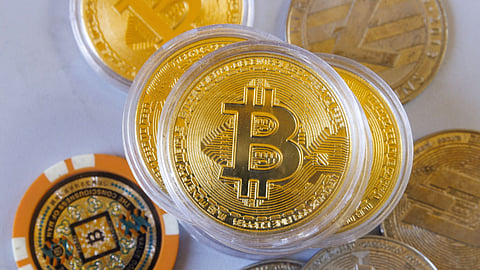Bitcoin halving explained: How it impacts the crypto’s price
As Bitcoin approaches another halving, the crypto world buzzes with anticipation. This phenomenon, baked into Bitcoin's code since its inception, slashes miner rewards by half every few years. With each reduction, Bitcoin's value has historically soared. Yet, opinions differ on whether halving directly drives these surges. Analysts predict the next halving could trigger an 81% upswing. Amidst debates, one thing remains certain: Bitcoin's volatile journey continues, leaving investors on edge.
Sign up for your early morning brew of the BizNews Insider to keep you up to speed with the content that matters. The newsletter will land in your inbox at 5:30am weekdays. Register here.
By Vildana Hajric and David Pan
Bitcoin is notoriously volatile, prone to sudden price surges and swift reversals that can wipe out millions of dollars of value in minutes. Those changes are often mysterious to market observers, because of the digital currency's lack of ties to the real economy. Bitcoin has another quirk, one that was built into the code that gave it birth: Every so often, the formula that governs the rate at which new tokens are created changes. As another such event — called a halving — approaches, Bitcoin supporters and skeptics are debating what kind of impact it may have on the coin's value. The coin hit records after each of the last three halvings and rose past its previous peak of $68,991.85 in March, making a comeback from a plunge in 2022.
1. Where do baby Bitcoin come from, anyway?
One of the characteristics that gave rise to a fascination with Bitcoin is the way its pseudonymous creator, Satoshi Nakamoto, tied the creation of coins to the work needed to prevent counterfeiting. Bitcoin is generated by so-called miners whose computers perform complex calculations that validate the transactions on what's known as the blockchain, a public digital ledger. The miners compete with each other to earn newly issued tokens, something known as a block reward.
2. What is a Bitcoin halving?
A halving – sometimes referred to as halvening – is a planned reduction in the rewards miners receive (the term is mentioned in Bitcoin's code). Halvings happen once every four years or so — more precisely, every 210,000 blocks of transactions. As the name suggests, each one cuts the quantity of Bitcoin that miners receive per block reward in half. At Bitcoin's launch in 2009, miners received 50 Bitcoin per block, but that reward was reduced to 25 in the first halving, in 2012, to 12.5 in 2016, 6.25 tokens in 2020 and is scheduled to drop to 3.125 coins in 2024. Analysts typically come out with estimates for when the halving might happen because a precise date tends to be difficult to pin down.
3. What's the point?
Bitcoin's issuance is limited in several ways. For one thing, according to its founding protocol, just 21 million will ever be in circulation. That's appealing to many who fear that fiat money — the kind issued by governments — can lose its value to inflation if too much is printed. Supporters argue that Bitcoin, by contrast, will be guaranteed to increase. Halving also prevents inflation by acting to periodically slow the pace at which Bitcoin are created, so as to not outstrip demand. To other observers, halvings can serve as a hurry-up-and-buy signal by suggesting that slower growth could be accompanied by a bump in price.Play Video
4. When is the next halving happening?
The quadrennial event is next due around April, according to a number of analysts, though it's difficult to zero-in on a date with certainty. That's because the time it takes to generate new blocks can slow down or speed up depending on a number of factors. Going by most estimates, there will be 64 Bitcoin halvings before that 21 million maximum is reached sometime around 2140, at which point halvings will stop. Once that happens, miners will no longer collect rewards and are expected to rely on charging fees for handling transactions, similar to what credit card companies do.
5. Do halvings boost Bitcoin's price?
That's a matter of heated debate. In 2012, for instance, Bitcoin gained about 8,000% in the 12 months following the cut in rewards, and again rose almost 1,000% in the wake of the 2016 cut. The last halving, in May of 2020, was followed by a bull run that ended in a record Bitcoin price of almost $69,000 in November 2021, though that period also coincided with a rally in other risk assets. The next halving holds the potential to trigger an advance of at least 81%, according to Bloomberg Intelligence and Matrixport. Skeptics, on the other hand, argue that attributing price hikes to halving is specious, at best. The second halving, for example, came at a time when Bitcoin was already gaining greater mainstream recognition, and coincided with the boom in initial coin offerings, many of which had to be bought with Bitcoin. A regulatory crackdown on crypto in the wake of the FTX exchange's collapse in November 2022 also threatens the market outlook. A flurry of spot Bitcoin exchange-traded funds have attracted a wider range of investors and spurred a sustained rally in early 2024.
6. If I own Bitcoin, will anything change for me after the halving?
No, except inasmuch as any subsequent price change would leave you richer or poorer. But it will be impossible to know how much of the change is due directly to the halving.
Read also:
© 2024 Bloomberg L.P.

